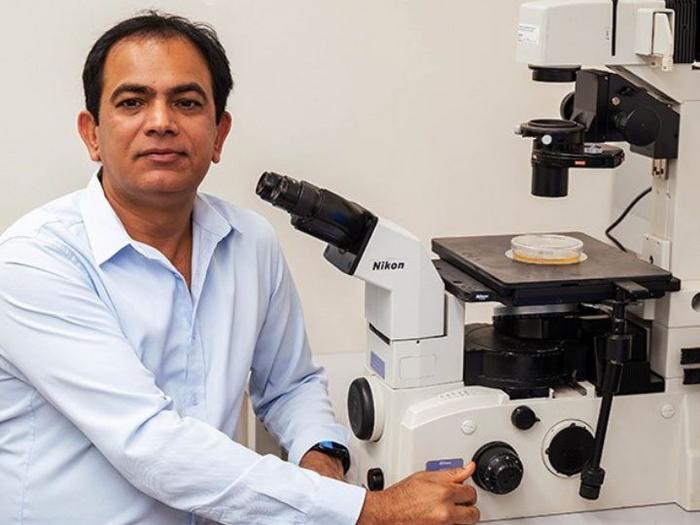
The landscape of pediatric oncology is fraught with challenges, particularly when addressing the aggressiveness of Rhabdomyosarcoma (RMS), a malignant soft tissue sarcoma predominantly affecting children. In a groundbreaking development, Ashok Kumar, the Else and Philip Hargrove Endowed Professor of Drug Discovery at the University of Houston College of Pharmacy, alongside his team, has received a substantial $3.2 million grant from the National Institutes of Health (NIH) aimed specifically at combating this devastating disease. The urgency of this research cannot be overstated, given that RMS accounts for approximately 8% of all pediatric cancers, underscoring the need for innovative treatment strategies to improve survival rates.
The reality of RMS is grim. Children diagnosed with this aggressive form of cancer face a survival rate of merely 20% to 30% when the disease has metastasized to other organs. This statistic not only highlights the severity of RMS but also illustrates the pressing need for effective interventions that can alter these outcomes. The research funded by the NIH aims to identify pivotal mechanisms integral to tumor progression in Rhabdomyosarcoma, with a focus on uncovering molecular targets that could lead to more effective therapeutic options.
A key focus of Kumar’s research is the role of a protein known as TAK1 (Transforming growth factor β-activated kinase 1). This protein, which is critical for regulating cellular growth and behavior, has been previously neglected in the context of RMS. Preliminary findings are promising; they suggest that TAK1 is significantly activated in both embryonal and alveolar RMS cells, as well as in human RMS tissue samples. These findings present a compelling case for further investigation into how TAK1 contributes to the relentless growth of RMS tumors.
Embryonal RMS typically presents in younger children, often manifesting in muscle-rich regions such as the head, neck, or perineum. Conversely, alveolar RMS tends to affect older children and adolescents, frequently arising in the body’s larger muscle groups such as the arms and legs. The differentiation between these two subtypes highlights the diverse nature of Rhabdomyosarcoma, necessitating varied therapeutic approaches tailored to the patient’s age and tumor characteristics.
The research team’s hypothesis revolves around the notion that inhibiting TAK1 could potentially halt the malignancy’s aggressive tendencies. Kumar has highlighted the success of preliminary laboratory tests that employ both genetic (genetic engineering) and pharmacological means to block TAK1’s activity. By doing so, the team has observed a curtailment in harmful cellular behaviors that are characteristic of cancerous cells.
Yet, significant questions remain. How exactly does TAK1 facilitate the growth and metastasis of RMS? Additionally, what mechanisms prevent RMS cells from differentiating into functional muscle tissue? Unraveling these mysteries is pivotal for developing effective treatment strategies. Kumar’s team aims to dissect the tumorigenic pathways activated by TAK1 and explore the therapeutic potential of its inhibition.
The implications of this research could extend beyond just Rhabdomyosarcoma, as understanding TAK1’s role could provide insights into other types of sarcomas and cancers. The potential to develop targeted therapies that specifically inhibit this protein could revolutionize the treatment paradigm not only for RMS but for a spectrum of malignancies marked by similar molecular characteristics.
Scholarly investigations into the principles of cellular biology have long established that uncontrolled cell growth is a hallmark of cancer. Kumar’s focus on TAK1 converges with broader cancer research trends, which increasingly emphasize the importance of identifying and targeting key molecular players that drive tumor progression. This approach aligns well with the contemporary paradigm shift toward precision medicine, where therapies are tailored based on individual molecular profiles.
The integration of holistic therapeutic strategies, utilizing both genetic manipulation and pharmacological agents, provides a dual-pronged attack against the relentless progression of RMS. This multifaceted approach promises to synergize the effects of various treatments, potentially leading to improved clinical outcomes for affected children. The ongoing research underscores the hope that new insights into the cellular mechanisms driving Rhabdomyosarcoma can pave the way for transformative advancements in treatment.
Kumar’s investigation stands as a beacon of hope for pediatric oncologists and families alike. With child cancer cases typically evoking emotional and psychological turmoil, the prospect of enhanced therapeutic modalities offers a ray of optimism. As the research unfolds, the goal remains clear: to transform insights gathered from the laboratory into tangible benefits for young patients grappling with this formidable adversary.
In conclusion, the relentless pursuit of knowledge within the scientific community continues to drive advancements in cancer research. The focus on TAK1 within the context of Rhabdomyosarcoma is an exemplary model of how targeted research efforts, supported by significant funding, can lead to the development of innovative therapies. With each study, researchers inch closer to unearthing the intricate workings of cancer biology, fortifying the foundations for potentially life-saving treatments for the youngest and most vulnerable members of society.
Subject of Research: Investigating the role of TAK1 in Rhabdomyosarcoma and its potential as a therapeutic target.
Article Title: Groundbreaking Research Aims to Tackle Rhabdomyosarcoma with $3.2 Million NIH Grant
News Publication Date: October 2023
Web References:
References:
Image Credits: University of Houston
Keywords: Rhabdomyosarcoma, cancer research, TAK1, pediatric oncology, NIH grant, tumor progression, molecular targets, drug discovery, gene targeting, pharmacological approaches.
Tags: aggressive childhood cancersAshok Kumar drug discoverycancer survival rates in childrenchildhood cancer researchinnovative therapies for pediatric cancermolecular targets in cancer therapyNIH grant for cancer researchpediatric oncology advancementsRhabdomyosarcoma treatment strategiessoft tissue sarcoma in childrentumor progression mechanismsUniversity of Houston research initiatives





